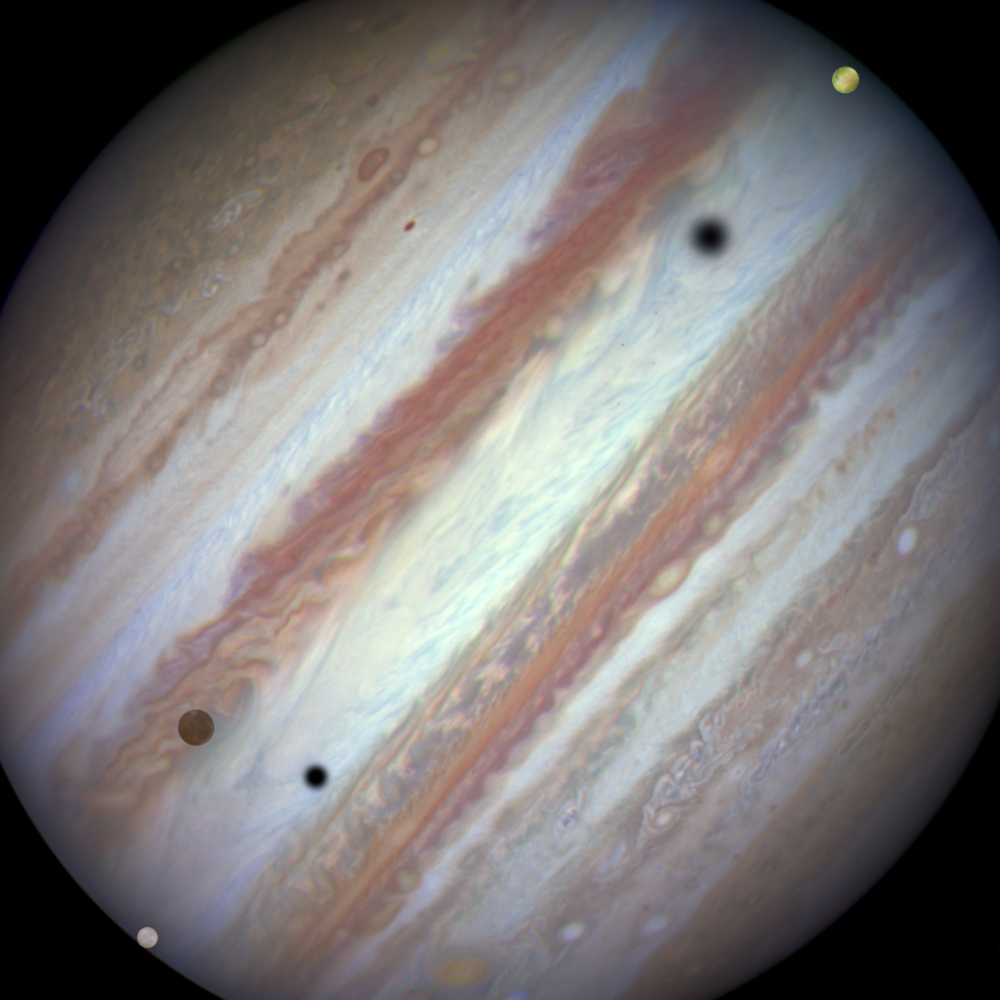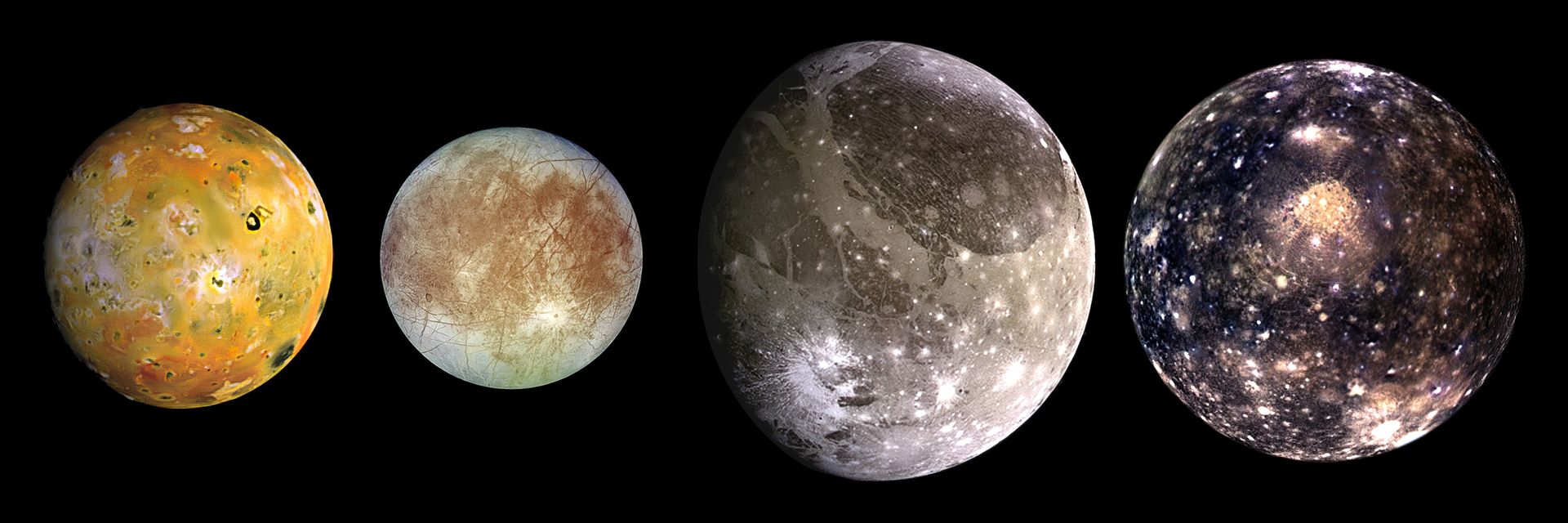The night’s sky has always twinkled with stars, planets, and the occasional comet, turning heads in every corner of the Earth. Since they came into view, Jupiter’s moons have changed our understanding of the Solar System and raised questions about the possibility of life beyond Earth.
◊
For as long as human beings have inhabited this planet, space has loomed above us. It has inspired folklore, religious beliefs, scientific inquiries, and ethical questions about intragalactic colonization by humans. In the time between the Renaissance and the Enlightenment, Italian astronomer Galileo Galilei began using the most recent technological developments to investigate what were deemed the “heavenly bodies.” His discoveries sparked centuries of investigations into the chemical, geological, and potentially biological goings-on of the planet Jupiter and its moons.
Today, scientific agencies are vying for funding to send high-tech satellites and probes deep into the Solar System to see how the icy oceans they have detected on Jupiter’s moons might support life forms. Within the last year, scientists have tallied its total number of moons as 92, meaning Jupiter has the most satellites of any planet in our system.
Watch “The Moons of Olympus” as a part of Space: The New Frontier.
How We Saw Jupiter … before We Could Get a Good Look
Earth takes 365 and a quarter days to make an orbit around the Sun. A Jovian year, by comparison, is the equivalent of 12 Earth years. The largest planet in the Solar System, Jupiter is easy to pick out in the night sky and can be seen for much of the year, depending on your location on Earth. While apps and computer-generated astrological trackers make it possible to point out planets and stars in an instant, everyday people in ancient times shared essentially the same view of the sky, though theirs was more clear thanks to the absence of light pollution.
The Formation of the Gas Giant
A bright dot in an otherwise dark vacuum of nothingness, Jupiter has cemented its image as a giant throughout literature, mythology, and folklore. Given its composition of hydrogen and helium, scientists believe Jupiter was the first planet to emerge in our Solar System. Its chemistry indicates that it was formed from light gasses that blew off the Sun and condensed into a ball. The massive amount of gaseous matter that coalesced established a gravitational force that has kept the planet in a constant state of slowly shrinking ever since. Jupiter is visible to the naked eye, and though it gets smaller year after year, it can still be spotted in the night sky– identifiable as being brighter and slightly yellowish compared to other bodies in the Milky Way.
What the Science Shows Us
Since Jupiter caught our eye, humans have been developing tools and techniques to better understand the goings-on of the worlds suspended above and around us. Advances in telescopic machines paired with mathematical developments in calculus propelled scientists’ study of space into a new era of exploration. Meticulous observations of the movements of planets recorded over the past centuries have revealed patterns, unveiling truths about the nature of our Solar System. Advances throughout the 20th century enabled physicists and engineers to create machines not just capable of reaching the deepest parts of the oceans and the bounds of our atmosphere, but also of collecting data in inhospitable realms far from Earth where no human being could step foot.
Missions to Jupiter’s Moons
Pioneer 10
In 1973, NASA’s Pioneer 10 spacecraft made the first ever flyby of Jupiter, capturing data about the planet’s physical forces and environmental makeup. Using all-nuclear electric power, this spacecraft was the first ever to fly through the main asteroid belt, the first to fly beyond Mars, and notably the first man-made object to travel beyond Neptune. A few other spacecraft made similar voyages, but none had traveled nearly as far before NASA created a dedicated mission for diving deep into Jupiter’s composition.
A close up of the metal plaque attached to Pioneer 10. (Credit: NASA Ames)
Galileo
Almost 350 years after he died, Galileo Galilei lent his name to a much more high-tech body. In 1989, NASA launched the Galileo mission that would take six years to reach Jupiter. This mission saw the spacecraft make 34 orbits around the planet over the course of eight years.

View of Europa taken by Galileo’s Camera. (Credit: NASA/JPL/University of Arizona)
The mission discovered that the moon Ganymede possessed a magnetic field, making it the first observed around a planetary satellite. Galileo was also the first mission to deploy a probe into another planet’s atmosphere, giving scientists insight into conditions on Jupiter in a way we had previously been unable to investigate. The most notable discovery of the mission was that Europa, a moon smaller than ours, has a global liquid-water ocean beneath its icy crust.
Hubble Space Telescope
Beyond the Galileo mission, scientists have continued to make significant discoveries about the potential for life on Jupiter’s moons through advances in imaging. When the Hubble Space Telescope was launched in 1990, scientists could harness the latest in optical technology to capture high definition photographs in wavelengths of light from ultraviolet to infrared. By examining the ultraviolet wavelengths to determine oxygen levels at various orbital points, images taken by the Hubble in 1991 indicated the presence of water in both Ganymede’s and Europa’s atmospheres.
Juno
For an even closer look at the makeup of Jupiter and its satellites, NASA launched the Juno mission in 2011 to explore the meteorological systems swirling across the planet. Over the course of 35 orbits, Juno detected multiple large cyclones around both the northern and southern poles of the planet. To highlight the scale of Jupiter, some of these weather systems are the size of Earth. Jupiter’s famous Red Spot is 20,000 by 12,000 km in size and has been terrorizing the planet for more than 350 years. Juno recorded data of wind flow hundreds of miles beneath its billowing clouds, and its camera captured images of colors on Jupiter that cannot be detected by the human eye.

Depiction of the Juno Spacecraft above Jupiter’s Red Spot. (Credit: NASA/JPL-Caltech)
James Webb Space Telescope
More recently, the James Webb Space Telescope captured spectroscopic data revealing traces of elements and chemicals that could not be seen before. The images show auroras at both the northern and southern poles of the planet, while also showcasing two of Jupiter’s smaller moons, Amalthea and Adrastea, and diffractions from other moons. The high-quality images have stirred up greater anticipation for the European Space Agency’s latest mission focused on exploring the gas giant’s many satellites.
Looking to the Next Big Mission
The JUpiter ICy moons Explorer (JUICE) will investigate Ganymede, Callisto, and Europa through flybys and an orbit of Ganymede. The focus on Europa will be examining the moon’s chemistry, particularly its non-water-ice materials, and discerning what organic molecules can be found. For Ganymede and Callisto, scientists are more interested in understanding the geological layers of the moons, studying their exospheres, and characterizing their magnetic fields in relation to the larger Jovian magnetosphere.
Set to take off on April 14, 2023, from French Guiana, JUICE will take up to eight years to reach Jupiter, followed by three years of planned orbiting. At the end of its mission, the spacecraft will make an impact on the surface of Ganymede. One of the primary objectives of the JUICE voyage is to clue scientists into the evolution of Jupiter and its moons, providing insight into the potential, or lack thereof, for supporting organic biological life.
The Water Moons of Jupiter
Europa’s watery makeup is a groundbreaking discovery in the history of space exploration. In fact, of the four Galilean moons, three are thought to contain subsurface liquid oceans. Europa, Ganymede, and Callisto each feature an icy exterior crust on top of a core composed of layers and mixtures of rock and ice. Io, the outlier, is a geologically violent world with 100 times more volcanic activity than is experienced on Earth.

Shadows of Europa, Callisto, and Io are cast on Jupiter. (Credit: Hubble Space Telescope / NASA Goddard)
Due to its closer proximity to Jupiter – and consequently greater gravitational pull – Io has a recorded 400 volcanoes dotted around its dry environment. While they may not spew the magma that Io does, the other moons have been photographed ejecting plumes of water into space, leading scientists to suspect that hydrothermal vents have created geysers along their ocean floors.
The average daytime temperature on Europa is -260 degrees Fahrenheit, but subterranean heating created by tidal energy enables water on the moon to retain a liquid form. The water beneath the icy crust can be so warm that scientists deduce there may be volcanoes on the seafloor. Between the long-duration storms that plague Jupiter and the hydrothermal activities that seem to be ongoing across some of its moons, the Jovian system is like an extraterrestrial water park with attractions above and below.
While water and ice seem abundant on Europa and other moons, it does not mean that these are environments primed to support biological life – not even future human explorers. The search for water within the Solar System has been a cornerstone of space exploration, and Europa’s conditions have identified it as a prime target for establishing a base for future missions. Even so, the water isn’t exactly the drinkable type, and Jupiter’s high levels of radiation leave some large hurdles in the way of humans heading that far out into the Solar System.
Earth 2.0 or Hell Frozen Over?
As humans look into the galaxy for worlds that could support life, the question becomes hard to ignore: Why are we looking to space for a place to support life?
Are we hoping to escape what could be an impending crisis of overpopulation, global warming, and resource depletion? Is it essential for protecting our planet from extraterrestrial threats? Could it be a good real estate investment?
Famed astronomer Carl Sagan said, “Since, in the long run, every planetary civilization will be endangered by impacts from space, every surviving civilization is obliged to become spacefaring – not because of exploratory or romantic zeal, but for the most practical reason imaginable: staying alive. . . . If our long-term survival is at stake, we have a basic responsibility to our species to venture to other worlds.” Stephen Hawking agreed.
Perhaps we have passed the point of needing to question why we are looking and ought to turn instead to question how we’re looking. The history so far of humans’ exploration of Jupiter and its moons reflects a journey of thoughtful inquiry, patient probing, and evidence-backed discovery that has and will continue to inform not just the future of science, but that of the Solar System itself.
Ω
Daisy Dow is a contributing writer for MagellanTV. She also writes for Local Life magazine. Originally from Georgia, she went to college to study philosophy and studio art. She now works in Chicago as a local media specialist.
Title Image: Galilean Moons (Credit: NASA, Public domain, via Wikimedia Commons)

